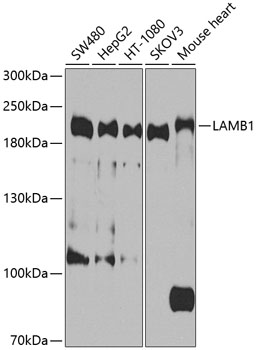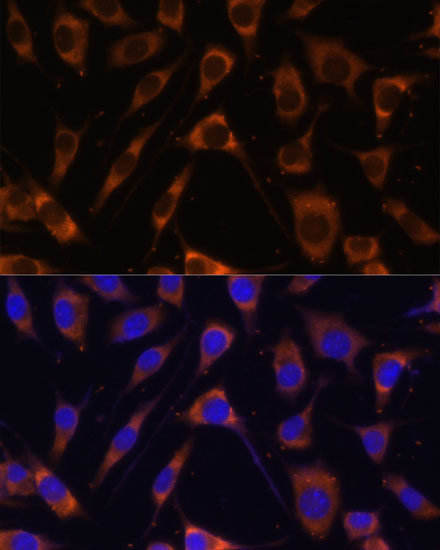Cell Biology Antibodies 12
Anti-LAMB1 Antibody (CAB9827)
- SKU:
- CAB9827
- Product Type:
- Antibody
- Applications:
- WB
- Applications:
- IHC
- Reactivity:
- Human
- Reactivity:
- Mouse
- Reactivity:
- Rat
- Host Species:
- Rabbit
- Isotype:
- IgG
- Research Area:
- Cell Biology
Description
| Antibody Name: | Anti-LAMB1 Antibody |
| Antibody SKU: | CAB9827 |
| Antibody Size: | 20uL, 50uL, 100uL |
| Application: | WB IHC IF |
| Reactivity: | Human, Mouse |
| Host Species: | Rabbit |
| Immunogen: | Recombinant fusion protein containing a sequence corresponding to amino acids 1467-1786 of human LAMB1 (NP_002282.2). |
| Application: | WB IHC IF |
| Recommended Dilution: | WB 1:1000 - 1:4000 IHC 1:10 - 1:200 IF 1:50 - 1:200 |
| Reactivity: | Human, Mouse |
| Positive Samples: | SW480, HepG2, HT-1080, SKOV3, Mouse heart |
| Immunogen: | Recombinant fusion protein containing a sequence corresponding to amino acids 1467-1786 of human LAMB1 (NP_002282.2). |
| Purification Method: | Affinity purification |
| Storage Buffer: | Store at -20'C. Avoid freeze / thaw cycles. Buffer: PBS with 0.02% sodium azide, 50% glycerol, pH7.3. |
| Isotype: | IgG |
| Sequence: | EAKL RADE AKQS AEDI LLKT NATK EKMD KSNE ELRN LIKQ IRNF LTQD SADL DSIE AVAN EVLK MEMP STPQ QLQN LTED IRER VESL SQVE VILQ HSAA DIAR AEML LEEA KRAS KSAT DVKV TADM VKEA LEEA EKAQ VAAE KAIK QADE DIQG TQNL LTSI ESET AASE ETLF NASQ RISE LERN VEEL KRKA AQNS GEAE YIEK VVYT VKQS AEDV KKTL DGEL DEKY KKVE NLIA KKTE ESAD ARRK AEML QNEA KTLL AQAN SKLQ LLKD LERK YEDN QRYL EDKA QELA RLEG EVRS LLKD ISQK VAVY STCL |
| Gene ID: | 3912 |
| Uniprot: | P07942 |
| Cellular Location: | Secreted, basement membrane, extracellular matrix, extracellular space |
| Calculated MW: | 198kDa |
| Observed MW: | 198kDa |
| Synonyms: | LAMB1, CLM, LIS5 |
| Background: | Laminins, a family of extracellular matrix glycoproteins, are the major noncollagenous constituent of basement membranes. They have been implicated in a wide variety of biological processes including cell adhesion, differentiation, migration, signaling, neurite outgrowth and metastasis. Laminins are composed of 3 non identical chains: laminin alpha, beta and gamma (formerly A, B1, and B2, respectively) and they form a cruciform structure consisting of 3 short arms, each formed by a different chain, and a long arm composed of all 3 chains. Each laminin chain is a multidomain protein encoded by a distinct gene. Several isoforms of each chain have been described. Different alpha, beta and gamma chain isomers combine to give rise to different heterotrimeric laminin isoforms which are designated by Arabic numerals in the order of their discovery, i.e. alpha1beta1gamma1 heterotrimer is laminin 1. The biological functions of the different chains and trimer molecules are largely unknown, but some of the chains have been shown to differ with respect to their tissue distribution, presumably reflecting diverse functions in vivo. This gene encodes the beta chain isoform laminin, beta 1. The beta 1 chain has 7 structurally distinct domains which it shares with other beta chain isomers. The C-terminal helical region containing domains I and II are separated by domain alpha, domains III and V contain several EGF-like repeats, and domains IV and VI have a globular conformation. Laminin, beta 1 is expressed in most tissues that produce basement membranes, and is one of the 3 chains constituting laminin 1, the first laminin isolated from Engelbreth-Holm-Swarm (EHS) tumor. A sequence in the beta 1 chain that is involved in cell attachment, chemotaxis, and binding to the laminin receptor was identified and shown to have the capacity to inhibit metastasis. |
| UniProt Protein Function: | Binding to cells via a high affinity receptor, laminin is thought to mediate the attachment, migration and organization of cells into tissues during embryonic development by interacting with other extracellular matrix components. Involved in the organization of the laminar architecture of cerebral cortex. It is probably required for the integrity of the basement membrane/glia limitans that serves as an anchor point for the endfeet of radial glial cells and as a physical barrier to migrating neurons. Radial glial cells play a central role in cerebral cortical development, where they act both as the proliferative unit of the cerebral cortex and a scaffold for neurons migrating toward the pial surface. |
| NCBI Summary: | Laminins, a family of extracellular matrix glycoproteins, are the major noncollagenous constituent of basement membranes. They have been implicated in a wide variety of biological processes including cell adhesion, differentiation, migration, signaling, neurite outgrowth and metastasis. Laminins are composed of 3 non identical chains: laminin alpha, beta and gamma (formerly A, B1, and B2, respectively) and they form a cruciform structure consisting of 3 short arms, each formed by a different chain, and a long arm composed of all 3 chains. Each laminin chain is a multidomain protein encoded by a distinct gene. Several isoforms of each chain have been described. Different alpha, beta and gamma chain isomers combine to give rise to different heterotrimeric laminin isoforms which are designated by Arabic numerals in the order of their discovery, i.e. alpha1beta1gamma1 heterotrimer is laminin 1. The biological functions of the different chains and trimer molecules are largely unknown, but some of the chains have been shown to differ with respect to their tissue distribution, presumably reflecting diverse functions in vivo. This gene encodes the beta chain isoform laminin, beta 1. The beta 1 chain has 7 structurally distinct domains which it shares with other beta chain isomers. The C-terminal helical region containing domains I and II are separated by domain alpha, domains III and V contain several EGF-like repeats, and domains IV and VI have a globular conformation. Laminin, beta 1 is expressed in most tissues that produce basement membranes, and is one of the 3 chains constituting laminin 1, the first laminin isolated from Engelbreth-Holm-Swarm (EHS) tumor. A sequence in the beta 1 chain that is involved in cell attachment, chemotaxis, and binding to the laminin receptor was identified and shown to have the capacity to inhibit metastasis. [provided by RefSeq, Aug 2011] |
| UniProt Code: | P07942 |
| NCBI GenInfo Identifier: | 317373377 |
| NCBI Gene ID: | 3912 |
| NCBI Accession: | P07942.2 |
| UniProt Secondary Accession: | P07942,Q14D91, |
| UniProt Related Accession: | P07942 |
| Molecular Weight: | 198,038 Da |
| NCBI Full Name: | Laminin subunit beta-1 |
| NCBI Synonym Full Names: | laminin subunit beta 1 |
| NCBI Official Symbol: | LAMB1 |
| NCBI Official Synonym Symbols: | CLM; LIS5 |
| NCBI Protein Information: | laminin subunit beta-1 |
| UniProt Protein Name: | Laminin subunit beta-1 |
| UniProt Synonym Protein Names: | Laminin B1 chain; Laminin-1 subunit beta; Laminin-10 subunit beta; Laminin-12 subunit beta; Laminin-2 subunit beta; Laminin-6 subunit beta; Laminin-8 subunit beta |
| Protein Family: | Laminin |
| UniProt Gene Name: | LAMB1 |
View AllClose




![Anti-LAMB1 Antibody (CAB19970)[KO Validated] Anti-LAMB1 Antibody (CAB19970)[KO Validated]](https://cdn11.bigcommerce.com/s-rd6ounxcu2/images/stencil/590x590/products/56137/61319/anti-lamb1-antibody-cab19970ko-validated__48577__52444.1706533768.jpg?c=1)



